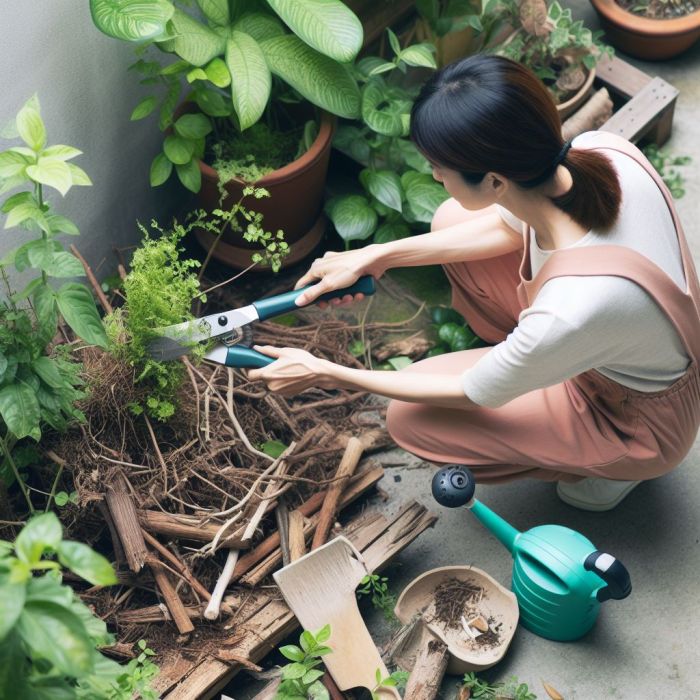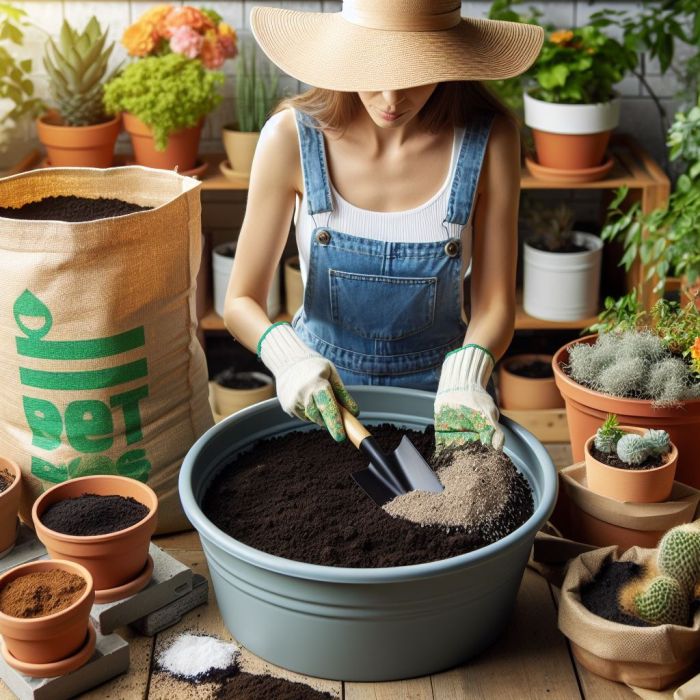Last updated on March 8th, 2024 at 06:30 am
Spring is the ideal season to breathe new life into your garden and prepare it for the vibrant months ahead. Whether you’re a seasoned green thumb or just starting out, there are essential tasks to ensure your garden thrives. One crucial step in this process is conducting a thorough “Spring Cleaning Tasks for the Garden,” which involves assessing the condition of your outdoor space and making a plan for cleanup and maintenance.
Wait for the soil to dry adequately before walking on it to avoid compacting it, but don’t delay too long as it’s crucial to clear away debris and fallen branches before they become tangled with new growth. This not only improves the appearance of your garden but also reduces the risk of pests, diseases, and weeds.
As you embark on your spring cleaning journey, consider incorporating compost or organic matter to enrich the soil and promote healthy plant growth, a vital “Spring Cleaning Tasks for the Garden.” Pruning is another important task to encourage bushier growth and better flowering. Take the time to divide overcrowded perennials and transplant any plants that have outgrown their current location, allowing them to establish in their new spot before the heat of summer arrives.
Additionally, inspect your irrigation system for any damage or leaks and adjust watering schedules accordingly.
Following a comprehensive checklist tailored to your garden’s needs will help ensure no task is overlooked. Take advantage of helpful gardening tools and equipment to streamline the process and make the job more manageable. Remember to enjoy the process of spring cleaning tasks for the garden, knowing that your efforts now will pay off in the form of a lush and vibrant outdoor sanctuary for you to enjoy throughout the seasons ahead.
Contents
- 1 Spring Cleaning Tasks for the Garden: Clearing Debris for Healthy Growth
- 2 Spring Cleaning Tasks for the Garden: Pruning and Trimming for Healthy Growth
- 3 Spring Cleaning Tasks for the Garden: Soil Preparation for Thriving Plants
- 4 Spring Cleaning Tasks for the Garden: Weed Control for Healthy Plant Growth
- 5 Assessing and Planning:
- 6 Dividing and Transplanting:
- 7 Cleaning and Maintaining Tools:
- 8 Irrigation Systems
- 9 Pest and Disease Prevention:
- 10 Enhancing Soil Health and Weed Suppression:
- 11 FAQS
- 11.1 When is the best time to start the spring cleaning tasks for the garden?
- 11.2 What tools do I need for the spring cleaning tasks for the garden?
- 11.3 How often should I prune and trim my plants during spring cleaning tasks for the garden?
- 11.4 Why is soil preparation important for a successful growing season?
- 11.5 How can I control weeds in my garden during spring cleaning?
- 12 Author
Spring Cleaning Tasks for the Garden: Clearing Debris for Healthy Growth

As you embark on your spring cleaning journey in the garden, prioritizing the task of clearing debris is crucial for setting the stage for a vibrant and flourishing outdoor space, a fundamental “Spring Cleaning tasks for the Garden.” Throughout the winter, fallen branches, dead leaves, and other organic matter can accumulate, creating a haven for pests and diseases that can harm your plants.
By promptly addressing this issue, you not only improve the aesthetic appeal of your garden but also create a healthier environment for your plants to thrive. Timing is key when it comes to tackling this task. Wait until the soil has dried adequately to avoid compacting it while removing debris. However, it’s important not to delay too long, as addressing this task early ensures that old growth doesn’t become entangled with new growth, making cleanup more challenging.
Utilize tools such as rakes and leaf blowers to efficiently gather debris from your lawn, garden beds, and pathways. Be thorough in your efforts, ensuring that no corner is left untouched. Once gathered, dispose of the debris responsibly by adding it to your compost pile or placing it in waste bins designated for organic matter. Avoid burning debris, as this can release harmful pollutants into the air and pose a fire hazard.
In addition to improving the overall health of your garden, clearing debris enhances safety and accessibility for you and your family. It reduces the risk of slips and falls, making it easier to navigate your outdoor space with confidence.
By prioritizing the task of clearing debris as part of your spring cleaning routine, you’re taking proactive steps to create an environment where your plants can thrive. Embrace this essential aspect of garden maintenance, knowing that your efforts will be rewarded with a beautiful and flourishing garden throughout the seasons ahead.
Spring Cleaning Tasks for the Garden: Pruning and Trimming for Healthy Growth

Spring is the ideal time for pruning and trimming in the garden. Assess your plants for dead, damaged, or diseased branches, and remove them to promote healthy growth. Deadhead spent flowers to encourage new blooms. Shape and thin out woody perennials and shrubs for better airflow and aesthetics. Trim evergreen and semi-evergreen perennials to tidy up their appearance.
Use sharp, clean tools and dispose of pruned material properly. By conducting thorough pruning and trimming, you not only enhance the health and appearance of your garden but also set the stage for a season of vibrant growth and beauty. Remember to consider the timing of pruning for each plant species to ensure optimal results.
Spring Cleaning Tasks for the Garden: Soil Preparation for Thriving Plants

A crucial step in ensuring a bountiful and thriving garden during the upcoming growing season is the meticulous preparation of your soil. Taking the time to nurture the very foundation of your garden sets the groundwork for healthier plants and more abundant blooms.
Start this revitalizing journey by turning over the soil in your flower beds and vegetable patches. This process not only helps aerate the soil but also breaks up compacted areas that may have formed during the winter months. Aerating the soil facilitates better water drainage, encourages root development, and allows for improved nutrient absorption by plant roots.
Delve into your garden beds, gently overturning the soil with a shovel or garden fork. Take care not to disturb any emerging plants or delicate roots. This hands-on approach helps invigorate the soil, promoting a loose and well-structured foundation for your plants to flourish.
To enhance the fertility of your soil, introduce compost or organic matter. These valuable additions contribute essential nutrients and foster a nutrient-rich environment, laying the groundwork for robust plant growth. Compost, derived from decomposed organic materials, improves soil structure, retains moisture, and supports beneficial microbial activity.
Consider creating a compost pile within your garden or acquire compost from local sources to infuse your soil with organic richness. Alternatively, choose specific organic amendments that cater to the unique needs of your plants and soil type.
As you meticulously prepare your soil, envision it as the canvas upon which your garden masterpiece will unfold. Take pride in the foundational care you provide, recognizing that well-prepared soil not only nurtures plants but also establishes the groundwork for a vibrant and flourishing garden throughout the seasons. In this transformative process, the health of your soil becomes the cornerstone for the beauty and abundance that will grace your outdoor sanctuary in the months to come.
Spring Cleaning Tasks for the Garden: Weed Control for Healthy Plant Growth

Weed control is paramount to ensure the optimal health and vitality of your garden plants. Weeds are notorious for competing with your plants for essential resources such as nutrients, water, and sunlight, stunting their growth and reducing their overall productivity. To combat weeds effectively, it’s crucial to take proactive measures early in the season.
Employ manual methods such as hand-pulling weeds or use mulch to suppress their growth. Mulching not only acts as a physical barrier to inhibit weed germination and growth but also helps conserve soil moisture and regulate soil temperature. By diligently maintaining weed-free beds throughout the spring and summer, you create a favorable environment for your plants to thrive, free from the detrimental effects of weed competition.
Assessing and Planning:
Take advantage of the spring season to assess the current condition of your garden and strategize for future success, including the essential “Spring Cleaning Tasks for the Garden.” This opportune moment allows you to reflect on the performance of your plants from the previous year, identifying which ones thrived and which ones struggled.
By analyzing this information, you can make informed decisions about any necessary changes or improvements to your garden layout or plant selection. Identify areas that could benefit from additional plantings or landscaping adjustments, optimizing your garden space for maximum aesthetic appeal and productivity. This thoughtful planning process sets the stage for a successful growing season, ensuring that your garden reaches its full potential.
Dividing and Transplanting:

Spring presents an ideal opportunity to rejuvenate your garden by dividing overcrowded perennials and transplanting any shrubs or flowers that have outgrown their current location. Over time, plants can become overcrowded, leading to reduced vigor and flowering. Dividing these plants allows them to spread out and establish better in their new locations, promoting healthier growth and better overall performance. By strategically dividing and transplanting your plants in the spring, you not only improve their health and appearance but also enhance the visual appeal of your garden landscape.
Cleaning and Maintaining Tools:
Don’t overlook the importance of maintaining your gardening tools as part of your spring cleaning routine. Clean and sharpen pruners, shears, and shovels to ensure they’re in top condition for the season ahead. Properly maintained tools not only make gardening tasks easier and more efficient but also help prevent damage to your plants by ensuring clean cuts and precise pruning. Take the time to scrutinize each tool, addressing any issues or wear and tear to prolong their lifespan and optimize their performance in the garden.
Irrigation Systems

Your garden’s irrigation system plays a crucial role in maintaining plant health and vitality, particularly during the dry months of spring and summer. Take the time to inspect your irrigation system for any damage or leaks that may have occurred during the winter months. Ensure that sprinkler heads are functioning correctly and adjust watering schedules as needed based on seasonal changes in weather and plant requirements.
By addressing any issues promptly and maintaining optimal watering practices, you can provide your plants with the consistent moisture they need to thrive, promoting healthy growth and vibrant blooms throughout the growing season.
Pest and Disease Prevention:
Protecting your garden from pests and diseases is essential to ensure the long-term health and productivity of your plants. Inspect plants regularly for signs of pests or diseases and take appropriate action to prevent their spread. Remove any infected or infested plant material promptly to prevent further damage and consider using organic pest control to minimize harm to beneficial insects and wildlife.
By staying vigilant and proactive in your pest and disease management efforts, you can safeguard your garden’s health and maintain a thriving ecosystem that supports plant growth and biodiversity.
Enhancing Soil Health and Weed Suppression:
Applying a small amount of mulch around plants is a simple yet effective way to enhance soil health and suppress weed growth in your garden beds. Choose organic mulches such as shredded bark or compost, and spread them evenly around your plants to create a protective barrier. Mulch helps to protect soil moisture by reducing evaporation, regulating soil temperature, and improving soil structure as it breaks down with time.
Additionally, mulch acts as a natural weed suppressant, inhibiting weed germination and growth while providing a neat appearance to your garden beds. By incorporating mulching into your spring cleaning routine, you can promote healthy plant growth and minimize maintenance efforts throughout the growing season.
Each of these spring cleaning tasks plays a vital role in nurturing a thriving garden environment, promoting healthy plant growth, and maximizing your gardening success. By prioritizing these essential tasks and incorporating them into your spring cleaning routine, you set the stage for a season of lush foliage, vibrant blooms, and bountiful harvests.
FAQS
When is the best time to start the spring cleaning tasks for the garden?
Spring is the ideal time to start your garden cleanup, typically when temperatures begin to warm up and the soil starts to thaw. Aim to begin your spring cleaning tasks as soon as the soil is dry enough to work with, but not so dry that it’s difficult to dig.
What tools do I need for the spring cleaning tasks for the garden?
Essential tools for spring cleaning in the garden include rakes, shovels, pruning shears, leaf blowers, and garden forks. Additionally, consider having compost bins or waste bins on hand for disposing of debris, and ensure your tools are clean and sharpened for optimal performance.
How often should I prune and trim my plants during spring cleaning tasks for the garden?
The frequency of pruning and trimming depends on the specific needs of your plants. Generally, it’s best to prune woody perennials and shrubs in the spring to encourage new growth and flowering. Trim evergreen and semi-evergreen perennials to tidy up their foliage and promote new growth.
Why is soil preparation important for a successful growing season?
Soil preparation is essential for ensuring optimal plant growth and productivity. Turning over the soil helps aerate it, improving water drainage and root development. Adding compost or organic matter replenishes nutrients and enhances soil structure, creating an ideal environment for plant roots to thrive.
How can I control weeds in my garden during spring cleaning?
Weed control is crucial for maintaining the health and vitality of your garden plants. Employ manual methods such as hand-pulling weeds or use mulch to suppress their growth. Mulching not only inhibits weed germination but also conserves soil moisture and regulates soil temperature, creating a favorable environment for your plants to thrive.
In conclusion, as you embark on your spring cleaning tasks for the garden, remember that each of these essential steps plays a crucial role in nurturing a thriving outdoor sanctuary. From clearing debris and pruning plants to preparing the soil and controlling weeds, your efforts now will set the stage for a season of lush growth and vibrant blooms.
By prioritizing these spring cleaning tasks and incorporating them into your gardening routine, you’re not only creating a beautiful and productive garden but also fostering a deeper connection with nature. So roll up your sleeves, grab your gardening tools, and embrace the opportunity to breathe new life into your outdoor space. With each task completed, you’re one step closer to enjoying the beauty and abundance of your garden throughout the seasons ahead. Happy gardening!

